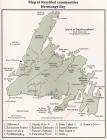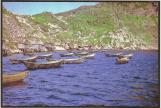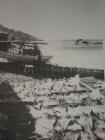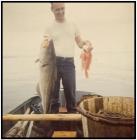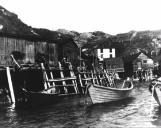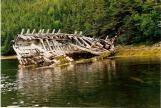2
All across the island of Newfoundland, people have built their livelihoods on the Atlantic fishing industry. Fishing was so important and fundamental to the people of Newfoundland, that it can even be attributed towards how the island's coastal communities have been formed and shaped. Dating back to as early as the 1700's, communities such as Grole, Great Jervais, Muddy Hole, Parson's Harbour, Pass Island, Pushthrough, Raymond's Point, Round Harbour, and Stone Valley all began as small fishing settlements which gradually grew over time.3
Western Harbour and the Garlands' stores, named "the room". Used to store salt fish, etc.1950-1960
Pushthrough, Newfoundland, Canada
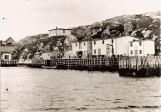
5
The last boat built in Pushthrough, built by Reg Garland and Sandy Kendall1960-1970
Pushthrough, Newfoundland, Canada
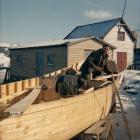
6
Each town, though similar in their livelihoods, were all started through different means and each has its own unique heritage. Some settlements such as Great Jervais began when businesses like the Newman Company brought servants to live near their fishing grounds, where they built houses and started families, growing in size and developing to suit the daily needs of its residents. Other towns, such as Pushthrough, began as fisherman and merchants and their families settled nearby harbors to establish fishing grounds or mercantile premises; gradually expanded as others moved in. Some communities like Parson's Harbour where their grounds have been popular fishing areas for generations can no longer trace the origin of how the town came to be and it remains unknown.7
Hedley Priddle, Carl Priddle's father, fishing.1960-1970
Pushthrough, Newfoundland, Canada
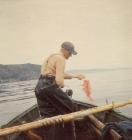 Credits:
Credits:Hedley Priddle
9
Regardless of how the settlements came to be, each town began, thrived and depended on the fishing industry for their way of life. It was more than a source of income, salt-cod and other yields were traded each year for household supplies and basic food staples for the coming winter. Fish would be traded for things like molasses, flour, rum, fishing equipment and even clothing material. These goods were all necessary provisions for families living in isolation on the coast, which did not have access to the luxury of a grocer or a department store like other larger, inland towns.11
Sandy and Norman Caines filling their cod oil barrel with cod liver1960-1970
Pushthrough, Newfoundland, Canada
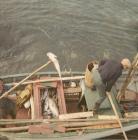
13
Over time, much way of life in these coastal towns remained unchanged, even as modernization sought to improve everyday life. Even the fishing industry was changing, as it moved away from salt-cod and towards a fresh-frozen market. Due to this, most communities gradually saw a population decline, and the government of Newfoundland introduced the Centralization and Resettlement programs. These programs sought to relocate the small populations of isolated towns towards nearby, larger communities. In 1965, the Resettlement Act was the final push.Pressured by the government, a decline of population and the hardships of isolated life, the people of places like Pushthrough, Round Harbour and the like, made the hard decision to leave their homes and ways of life behind for promises of a better future.
